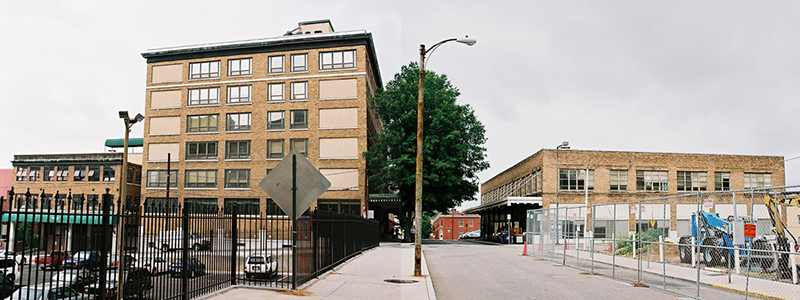Buildings and Blocks
Daylight Saving Time

Old buildings are like old people: they can be wonderful to have around, but at a cost. They connect us with our past, comfort us in our daily work, and keep us on the high road when we are pressured to take the easy route. They require maintenance, thoughtful concern, and affection. When they leave us, as they inevitably do, they are not easily replaced.
That's why the sunken parking lot where the Sprankle Building sat is so painful to consider. Promised a new (and rather tacky) bank that vaguely respected the scale and detailing of the old office/retail structure, we got a hole in the ground, an expensive iron fence, and a sprayed-concrete wall painted a sickly brown that tries to match the color of the brick on the adjacent building. Together they make up an artifact that, at its best, is a land bank for future development.
Opposite that lot sits the stately Pembroke residences, its parking garage, and the Daylight Building across the street on Union Avenue. All three buildings were built in the early 1930s by the Sprankle family as an extension of their holdings further down the block. Forming one of the few groupings of buildings in downtown, the complex could be considered an early example of 'urban design.' The Pembroke, originally known as the New Sprankle Building, housed the offices of the Tennessee Valley Authority, while the Daylight, appropriately named for its huge expanses of glass, contained the TVA boardrooms in the open space above and retail/storage uses on the ground and lower level. The site is flanked on its west and north sides by large parking lots.
The Daylight is clearly of comparable architectural quality to its siblings, sharing similar materials and design details. The stunning canopy that provides sun and rain protection matches other canopies along the length of Union. Its steel windows on the upper floor have resisted replacement by more energy-efficient anodized aluminum and provide a fine example of the frames that were so typical of early 20th century industrial and commercial building. The facade shares the same stone base that rises past the window sills at the ground floor, and the same yellow brick that, at its time, was a signature for 'modern.'
The property, containing 30,000 square feet of usable floor area and a full basement, was bought by Holrob Realty from Daylight Properties in December 2005 for an undisclosed price. Soon after, the tenants of the building (including the Union Avenue Barber Shop and the Bijou Theatre) vacated the premises, which have remained empty ever since. 'For Lease' signs appeared and a liquidation sale of furnishings and fixtures was held in August 2006. While rumors persist that the building will be demolished, a call to Holrob revealed only that the building might be available in its entirety for sale or 'for redevelopment.'
The Daylight is well constructed, seems structurally sound, and would likely outlast anything that could be built to replace it. Buildings like it - in their original state or usefully rehabilitated - can be found in any downtown of Knoxville's size, and being of its age, mark the history of the place. Its large open spaces would make it viable as a downtown community center (to replace the Candy Factory), a theater rehearsal or performance venue for groups like the Tennessee Stage, or a much-needed downtown food store such as an urban Whole Foods or Food Co-op. Its smaller spaces on the ground floor level could provide a series of shops similar to those along the street facades of Asheville's historic Grove Arcade. One could also have imagined it being connected to a downtown transit center that would occupy part of its lowest (basement) level in conjunction with one of the surface parking lots. In short, the building is a perfect candidate for adaptive reuse if one is ready and able to think creatively about its potential.
When the New Sprankle complex was built, free market and profit motive were as much forces in downtown development as they are today. Developers, looking toward a long life for their buildings, took pride in quality and seemed satisfied to make a fair profit on their investment. Perhaps it was their moral compass that led them to good deeds, perhaps gratitude that, in the middle of the Great Depression, they could earn a reasonable living from their properties. Those values of pride and modesty are embedded in the Daylight itself, and the building's continued presence reminds us that quality and profit can be balanced. Just as in our dealings with old people, we have the choice between expediency and doing the right thing.
©2007 Michael Kaplan. This article originally appeared in the Knoxville Voice.
